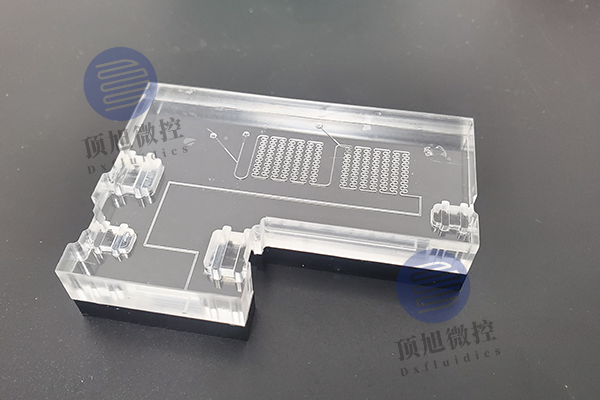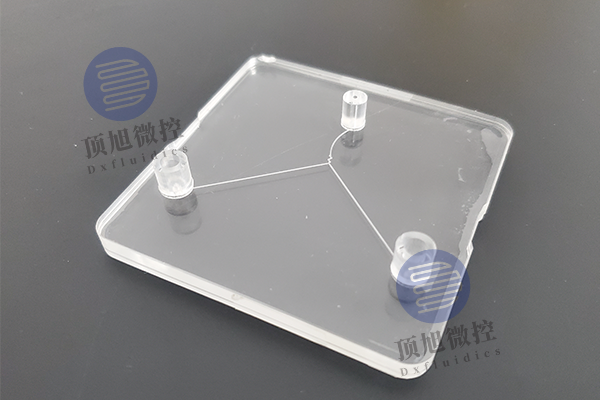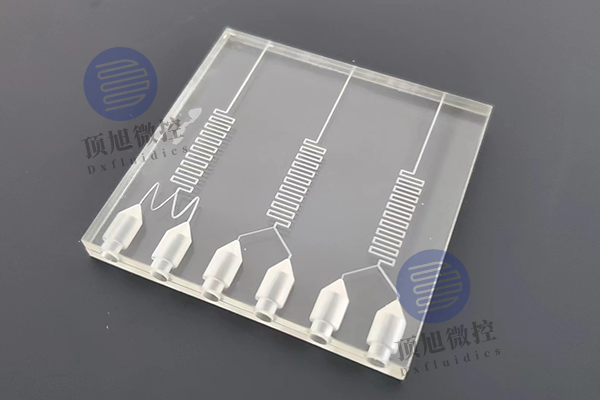Microfluidic plastic chips are tiny laboratory devices made of polymer materials with microchannels and microchambers for controlling and analyzing microfluids. Compared to traditional glass chips, plastic chips have the advantages of low cost, flexible preparation and easy processing.
Such chips are widely used in biomedicine, chemical analysis, environmental monitoring and other fields. Their tiny size and high degree of integration enable them to effectively perform experiments such as microreactions, cell culture, drug screening, etc., providing a convenient tool for laboratory research.
Microfluidic plastic chips play a key role in advancing microfluidics and facilitating the automation and high throughput of laboratory experiments.
1. Microfluidic Plastic Chip Materials
1.1 Polymethyl Methacrylate(PMMA)
PMMA Chip Material PMMA is an inexpensive and easy-to-manufacture polymer that is the least hydrophobic of the common plastic materials and is easily modified.
It is particularly useful for disposable microfluidic plastic chips due to its low price, rigid mechanical properties, excellent optical transparency and compatibility with electrophoresis. It is also ideal for the preparation of reusable microfluidic plastic chips.
PMMA chip dvantages: Low cost, hydrophilic among common plastics, rigid mechanical properties, excellent optical transparency, compatibility with electrophoresis, easy to manufacture and modify, reusable.
PMMA chip disadvantages: Expensive equipment required for complex chip fabrication (injection molding, hot embossing).
PMMA chip Common Applications: Eco-friendly microchips (reusable), hybrid analysis chips, DNA sequencers, electrophoresis chips.
PMMA chip Forming Methods: CO2-laser micromachining, injection molding, hot embossing, compression molding, and extrusion.
Glass Transition Temperature: 85-165°C (varies with grade).
1.2 Cycloolefin Copolymer (COC)
COC chips have good resistance to hydrolysis, acidic reagents, alkaline reagents, and most organic polar solvents such as acetone, methanol, and isopropanol.COC chip materials are highly transparent to light at wavelengths above 250 nm and have low autofluorescence.
The hydrophobicity of the surface of COC chips makes the chips fabricated with them susceptible to spontaneous nonspecific protein adsorption and cell adhesion when exposed to biological tissues or fluids, which prevents them from being the best choice for use in studies involving drugs.
Advantages of COC Chips:Excellent resistance to hydrolysis, resistance to acidic and alkaline substances, and most organic polar solvents. High transparency to light with wavelengths above 250nm, low autofluorescence, low birefringence, high Abbe number, and high heat resistance.Low water absorption and high dimensional stability.
Disadvantages of COC Chips:Expensive equipment is required for injection molding and hydrophobic surface treatment to mitigate analyte adsorption and reduce cell adhesion.
OC Chip Forming Methods:Single and twin-screw extrusion, injection molding, injection stretch blow molding (ISBM), compression molding, extrusion coating, biaxial orientation, thermoforming, and others.
Glass Transition Temperature: 70-177°C (depends on polymer content).
1.3 Polycarbonate (PC)
Polycarbonate (PC) is the preferred durable material for a range of microfluidic applications in biomedical research and bioanalysis. It is commonly used in DNA thermal cycling applications, such as Polymerase Chain Reaction (PCR), due to its visible light transparency and exceptionally high glass transition temperature (145°C).
Advantages of PC Chips:Durable material with high transparency in the visible light region.Extremely high glass transition temperature (~145°C), providing resilience.Low cost, high impact resistance, low moisture absorption, and good processing performance.
Disadvantages of PC Chips:Limited resistance to certain organic solvents, UV light absorption. Limited bonding quality and strength (restricted to heat bonding).Changes in channel geometry due to bonding temperature.
Common Applications:DNA thermal cycling, manufacturing of multilayer devices, enzyme-catalyzed amplification, nucleic acid separation, amplification product labeling, pathogen detection, and microfluidic injection ampereometric determination of glucose.
Glass Transition Temperature:145-155°C.
1.4 Polystyrene (PS)
Polystyrene (PS) is optically transparent, inert, biocompatible, rigid, inexpensive and easily commercialized thermoplastic material, which makes it the most commonly used material in cell culture.
The surface can be easily treated (using a variety of physical and chemical methods including irradiation, corona discharge or gas plasma) to make its hydrophobic surface more hydrophilic.
However, the need to use expensive equipment to process complex chips made of this polymer (injection molding, hot pressing) is a major drawback in chip prototyping, as PS is better suited for mass manufacturing processes.
Advantages of PS Chips:Optical transparency, biocompatibility, inertness.Easily treatable surface adaptable to mass manufacturing processes. High commercial availability, low cost, and quick bonding.
Disadvantages of PS Chips:Expensive equipment required for complex chip manufacturing (injection molding, hot pressing).Challenges in heat bonding during the manufacturing of chips with this polymer, especially when the width-to-height ratio is too high, leading to more channel collapses.
Common Applications:Cell culture research.
Potential Applications: Cell culture on microfluidic chips (organ-on-a-chip), utilizing plasma treatment or masking layers. Pre-coating microchannels with extracellular matrix proteins before cell seeding to facilitate cell adhesion and growth while preventing bubble formation.
Forming Methods: Injection molding, hot embossing.
Glass Transition Temperature: 92-107°C.
2 Processing Methods:
The primary processing methods include machining, hot embossing, and injection molding.
In the prototyping stage, machining is mainly used, while injection molding is favored for mass production. A variety of processing equipment is available to meet different customer needs at different stages.
3 Bonding Methods:
Microfluidic plastic chip bonding methods mainly include hot pressing, ultrasonic bonding, and laser bonding. Currently, hot bonding is the predominant method.
Dxfluidics Products



Ordering Methods



© 2025. All Rights Reserved. 苏ICP备2022036544号-1













